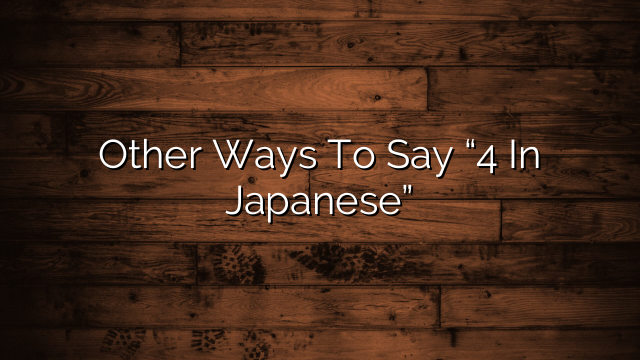In the realm of numerical expressions, the Japanese language unveils a plethora of alternatives to represent the number 4. This article delves into the various ways to say ‘4’ in Japanese, shedding light on the nuances and cultural significance embedded within each expression.
The first alternative is ‘shi,’ which bears an uncanny resemblance to the word for death, thus instilling a sense of superstition and aversion in some individuals. To counteract this perceived negativity, another pronunciation, ‘yon,’ emerges as a viable option.
Additionally, adhering to traditional customs, one can employ ‘yottsu,’ signifying four objects or entities. Furthermore, for those keen on symbolism and modernity, a symbolic representation in numeric form (‘4’) is gaining prevalence.
By examining these multiple facets of expressing ‘4’ in Japanese, readers will acquire a deeper understanding of how language intertwines with culture and belief systems.
Key Takeaways
- The Japanese language has multiple ways to represent the number 4.
- ‘Shi’ is commonly used but considered unlucky due to its resemblance to the word for death.
- ‘Yon’ is an alternative pronunciation to avoid superstition.
- ‘Yottsu’ is another traditional expression for the number 4.
Common Numerical Expression: Shi
The numerical expression ‘shi’ is commonly used in Japanese to represent the number 4. However, this expression holds significant cultural connotations as it is also considered an unlucky number due to its homonymic relationship with the word for death.
The pronunciation of ‘shi’ is similar to the word for death, which has led to a superstitious aversion towards using this number in various contexts. As a result, some buildings and hospitals may skip the fourth floor or omit room numbers containing the digit 4. In addition, it is common for gifts or items to be avoided if they have four units or are priced at multiples of four.
This superstition surrounding ‘shi’ reflects the cultural sensitivity and beliefs deeply ingrained in Japanese society when it comes to numbers and their associated meanings.
Alternative Pronunciation: Yon
alternative pronunciation: yon
Yon, a distinct pronunciation in the Japanese language, offers an alternative way to express the numerical value of four. In Japan, numbers hold cultural significance, and the number four is associated with bad luck due to its similar pronunciation to the word for death. To avoid this negative connotation, the alternative pronunciation ‘yon’ is used instead of ‘shi’ when counting or stating quantities.
This variation in pronunciation reflects the diversity present in different regions of Japan, where dialects and accents influence how numbers are spoken. These regional variations add complexity to the study of Japanese numerals and highlight the importance of understanding cultural context when using numerical expressions in conversation or formal settings.
Consequently, incorporating alternative pronunciations like ‘yon’ helps mitigate any potential offense or superstition associated with the number four in Japanese culture.
Traditional Expression: 四つ (Yottsu)
One traditional expression used in Japan to represent the numerical value of four is 四つ (yottsu).
In counting in Japanese, this word is commonly employed to indicate the quantity of four items or individuals.
The cultural significance of numbers in Japan is deeply rooted and often tied to superstitions and beliefs.
In the case of 四つ, it holds both positive and negative connotations.
On one hand, 四つ symbolizes stability and completeness due to its square shape, which can be seen as auspicious.
However, it also evokes feelings of unease as 四 (shi) shares a similar pronunciation with 死 (shi), meaning death.
This association has led to the avoidance of using 四 in certain contexts such as room numbers or gifts, where alternative expressions like ‘yon’ are preferred.
Counting Objects: Yonko
Counting objects in Japan can be done using the term ‘yonko,’ which adds a touch of intrigue and excitement to the act of quantifying items. This traditional way of counting is commonly used for inanimate objects, such as books or chairs.
However, it can also be applied to counting people and animals. When counting people, the term ‘yonin’ is used, representing four individuals. Similarly, when counting animals, the term ‘yonbiki’ is employed to signify four animals.
The use of ‘yonko’ not only provides a clear numerical value but also adds cultural significance by incorporating Japanese language and tradition into everyday activities. By utilizing this unique method of counting, individuals are able to infuse a sense of curiosity and appreciation for Japanese culture into their daily lives while accurately assessing quantities.
Symbolic Representation: 4
Symbolic representation of the number 4 in Japan is deeply rooted in cultural significance, providing a unique lens through which to view the country’s traditions and language.
In Japanese, the number 4 can be written as ‘4’ using Arabic numerals or as ‘四’ using kanji characters. The pronunciation of the number also varies depending on context. While it is commonly pronounced as ‘shi,’ which coincidentally means ‘death’ in Japanese, there are alternative pronunciations used to avoid this association.
For example, in certain situations, people may use ‘yon’ instead of ‘shi’ to refer to the number 4. This linguistic adaptation reflects an avoidance of perceived bad luck associated with death and demonstrates how deeply ingrained cultural beliefs shape everyday language usage in Japan.
Thus, understanding different ways numbers are represented and pronounced provides valuable insight into Japanese culture and communication norms.
Frequently Asked Questions
Are there any cultural or historical reasons for the alternative pronunciation of "4" as "yon"?
The alternative pronunciation of ‘4’ as ‘yon’ in Japanese is influenced by Chinese culture, specifically the Chinese pronunciation for the number 4. Additionally, in Japanese culture, the number 4 is associated with superstitions and beliefs related to death, leading to its avoidance in certain contexts.
Are there any specific contexts or situations where the traditional expression "yottsu" is commonly used?
The traditional expression ‘yottsu’ for the number 4 is commonly used in various situations, such as counting objects or when referring to quantities. The alternative pronunciation ‘yon’ holds cultural and historical significance in Japan.
Can the counting objects expression "yonko" be used for any type of objects, or are there specific rules or limitations?
The counting objects expression ‘yonko’ is commonly used in daily conversations to refer to four objects. It can be used for any type of objects without specific rules or limitations. The pronunciation and usage of ‘yon’ and ‘yottsu’ may vary in different Japanese dialects.
Is the symbolic representation "4" used more frequently in modern Japanese writing or is it mainly used in formal contexts?
The symbolic representation ‘4’ is commonly used in modern Japanese writing, particularly in formal contexts. The influence of Western numerals on Japanese writing and the evolution of numerical pronunciations have contributed to this prevalence.
Are there any regional variations in the usage or pronunciation of the number "4" in Japanese?
Regional variations in the usage and pronunciation of the number ‘4’ exist in Japanese. Different regions may use alternative words or expressions for ‘4’, while some dialects might have distinct pronunciations for this number.
Conclusion
In Japanese, there are various ways to express the number 4. The most common numerical expression is ‘shi,’ but an alternative pronunciation is ‘yon.’
Additionally, the traditional expression for 4 is ‘yottsu.’ When counting objects, the word ‘yonko’ is used.
Lastly, the symbolic representation of 4 is simply the numeral character ‘4.’
Each of these different expressions adds depth and richness to the language. Just like a painter using different shades of color to create a masterpiece, the Japanese language offers multiple ways to say 4, allowing for nuanced communication.


